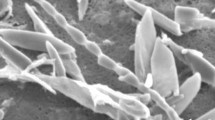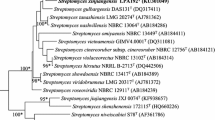Abstract
During a screening for novel and biotechnologically useful actinobacteria, a novel actinobacteria with weak antifungal activity, designated strain NEAU-Spg19T, was isolated from a soil sample collected from pine forest in Songpinggou, Sichuan, southwest China. The strain was characterized using a polyphasic taxonomic approach which confirmed that it belongs to the genus Streptomyces. Growth occurred at a temperature range of 10–30 °C, pH 5.0–11.0 and NaCl concentrations of 0–5 %. The cell wall peptidoglycan consisted of LL-diaminopimelic acid and glycine. The major menaquinones were MK-9(H6), MK-9(H8) and MK-9(H4). The phospholipid profile contained diphosphatidylglycerol (DPG), phosphatidylethanolamine and phosphatidylinositol. The major fatty acids were iso-C15:0, iso-C16:0, and C16:0. 16S rRNA gene sequence similarity studies showed that strain NEAU-Spg19T belongs to the genus Streptomyces with the highest sequence similarities to Streptomyces tauricus JCM 4837T (98.6 %) and Streptomyces rectiviolaceus JCM 9092T (98.3 %). Some physiological and biochemical properties and low DNA–DNA relatedness values enabled the strain to be differentiated from S. tauricus JCM 4837T and S. rectiviolaceus JCM 9092T. Hence, on the basis of phenotypic and genetic analyses, it is proposed that strain NEAU-Spg19T represents a novel species of the genus Streptomyces, for which the name Streptomyces songpinggouensis sp. nov. is proposed. The type strain is NEAU-Spg19T (=CGMCC 4.7140T=DSM 42141T).

Similar content being viewed by others
References
Waksman SA, Henrici AT (1943) The nomenclature and classification of the actinobacterias. J Bacteriol 46:337–34130
Lechevalier MP, Lechevalier HA (1980) The chemotaxonomy of actinobacterias. In: Dietz A, Thayer DW (eds) Actinobacteria taxonomy special publication, vol 6. Society of Industrial Microbiology, Arlington, pp 227–291
Mendes R, Kruijt M, De Bruijn I et al (2011) Deciphering the rhizosphere microbiome for disease-suppressive bacteria. Science 332:1097
Williams ST, Goodfellow M, Alderson G, Wellington EMH, Sneath PHA, Sackin MJ (1983) Numerical classification of Streptomyces and related genera. J Gen Microbiol 129:1743–1813
Goodfellow M, Fiedler HP (2010) A guide to successful bio-prospecting: informed by actinobacterial systematics. Antonie Van Leeuwenhoek 98:119–142
Broach JR, Thorner J (1996) High-throughput screening for drug discovery. Nature 384(6604):14–16
Fiedler HP (1993) Biosynthetic capacities of actinobacterias. 1 screening for secondary metabolites by HPLC and UV-visible absorbance spectral libraries. Nat Prod Lett 2(2):119–128
Balagurunathan R, Radhakrishnan M (2007) Actinobacterias: diversity and their importance. In: Trivedi PC (ed) Microbiology-applications and current trends. Pointer Publishers, Jaipur, pp 297–329
Xu XN, Wang LS (2002) Mountain hazard caused by earthquake in Songping River upper Minjiang and its controlling. Chin J Geol Hazard Control 13:31–35
Hayakawa M, Nonomura H (1987) Humic acid-vitamin agar, a new medium for selective isolation of soil actinobacterias. J Ferment Technol 65:501–509
Shirling EB, Gottlieb D (1966) Methods for characterization of Streptomyces species. Int Syst Bacteriol 16:313–340
Kelly KL (1964) Inter-society color council-national bureau of standards color-name charts illustrated with centroid colors. US Government Printing Office, Washington, DC
Xie QY, Lin HP, Li L (2012) Verrucosispora wenchangensis sp. nov., isolated from mangrove soil. Antonie Van Leeuwenhoek 102:1–7
Smibert RM, Krieg NR (1994) Phenotypic characterization. In: Gerhardt P, Murray RGE, Wood WA, Krieg NR (eds) Methods for general and molecular bacteriology. American Society for Microbiology, Washington, DC, pp 607–654
Am Yokota, Tamura T, Hasegawa T (1993) Catenuloplanes japonicas gen. nov., sp. nov., nom. rev., a new genus of the order Actinomycetales. Int J Syst Bacteriol 43:805–812
Minnikin DE, O’Donnell AG, Goodfellow M et al (1984) An integrated procedure for the extraction of bacterial isoprenoid quinones and polar lipids. J Microbiol Methods 2:233–241
McKerrow J, Vagg S, McKinney T et al (2000) Simple HPLC method for analysing diaminopimelic acid diastereomers in cell walls of Gram-positive bacteria. Lett Appl Microbiol 30:178–182
Collins MD (1985) Isoprenoid quinone analyses in bacterial classification and identification. In: Goodfellow M, Minnikin DE (eds) Chemical methods in bacterial systematics. Academic Press, London, pp 267–284
Wu C, Lu X, Qin M (1989) Analysis of menaquinone compound in microbial cells by HPLC. Microbiology 16:176–178 (English translation of Microbiology (Beijing))
Gao RX, Liu CX, Zhao JW et al (2014) Micromonospora jinlongensis sp. nov., isolated from muddy soil in China and emended description of the genus Micromonospora. Antonie Van Leeuwenhoek 105:307–315
Xiang WS, Liu CX, Wang XJ (2011) Actinoalloteichus nanshanensis sp. nov., isolated from the rhizosphere of a fig tree (Ficus religiosa). Int J Syst Evol Microbiol 61:1165–1169
Kim SB, Brown R et al (2000) Gordonia amicalis sp. nov., a novel dibenzothiophene-desulphurizing actinobacteria. Int J Syst Evol Microbiol 50:2031–2036
Saitou N, Nei M (1987) The neighbor-joining method: a new method for reconstructing phylogenetic trees. Mol Biol Evol 4:406–425
Felsenstein J (1981) Evolutionary trees from DNA sequences: a maximum likelihood approach. J Mol Evol 17:368–376
Tamura K, Stecher G, Peterson D et al (2013) MEGA6: molecular evolutionary genetics analysis version 6.0. Mol Biol Evol 30:2725–2729
Felsenstein J (1985) Confidence limits on phylogenies: an approach using the bootstrap. Evolution 39:783–791
Kimura M (1983) The neutral theory of molecular evolution. Cambridge University Press, Cambridge
Tamura K, Nei M (1993) Estimation of the number of nucleotide substitutions in the control region of mitochondrial DNA in humans and chimpanzees. Mol Biol Evol 10:512–526
Kim OS, Cho YJ, Lee K et al (2012) Introducing EzTaxon-e: a prokaryotic 16S rRNA gene sequence database with phylotypes that represent uncultured species. Int J Syst Evol Microbiol 62:716–721
Mandel M, Marmur J (1968) Use of ultraviolet absorbance temperature profile for determining the guanine plus cytosine content of DNA. Methods Enzymol 12:195–206
De Ley J, Cattoir H, Reynaerts A (1970) The quantitative measurement of DNA hybridization from renaturation rates. Eur J Biochem 12:133–142
Huss VAR, Festl H, Schleifer KH (1983) Studies on the spectrometric determination of DNA hybridisation from renaturation rates. Syst Appl Microbiol 4:184–192
Wayne LG, Brenner DJ, Colwell RR (1987) International committee on systematic bacteriology. Report of the ad hoc committee on reconciliation of approaches to bacterial systematics. Int J Syst Bacteriol 37:463–464
Acknowledgments
This work was supported in part by grants from the National Outstanding Youth Foundation (No. 31225024), the National Key Technology R&D Program (No. 2012BAD19B06), the National Natural Science Foundation of China (Nos. 31471832, 31171913, 31500010, 31572070 and 31372006) and Chang Jiang Scholar Candidates Program for Provincial Universities in Heilongjiang (CSCP).
Author information
Authors and Affiliations
Corresponding authors
Additional information
Xuejiao Guan and Wenchao Li have contributed equally to this work.
Electronic supplementary material
Below is the link to the electronic supplementary material.
Rights and permissions
About this article
Cite this article
Guan, X., Li, W., Liu, C. et al. Streptomyces songpinggouensis sp. nov., a Novel Actinomycete Isolated from Soil in Sichuan, China. Curr Microbiol 73, 796–801 (2016). https://doi.org/10.1007/s00284-016-1128-3
Received:
Accepted:
Published:
Issue Date:
DOI: https://doi.org/10.1007/s00284-016-1128-3




